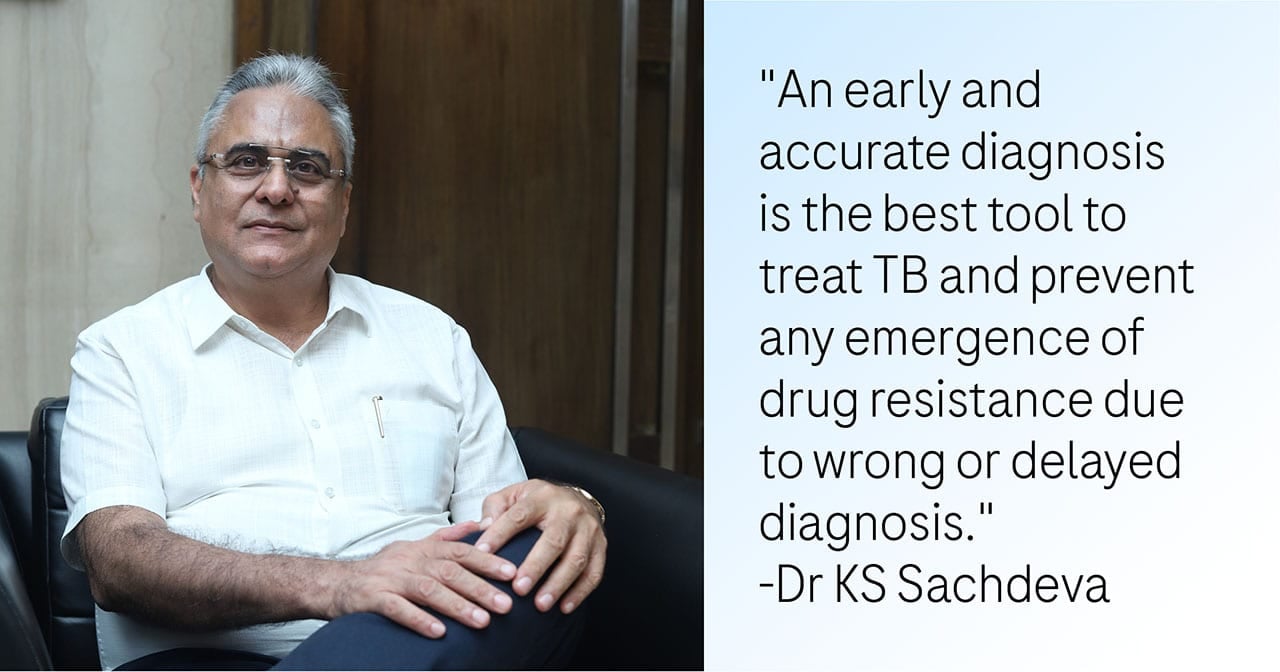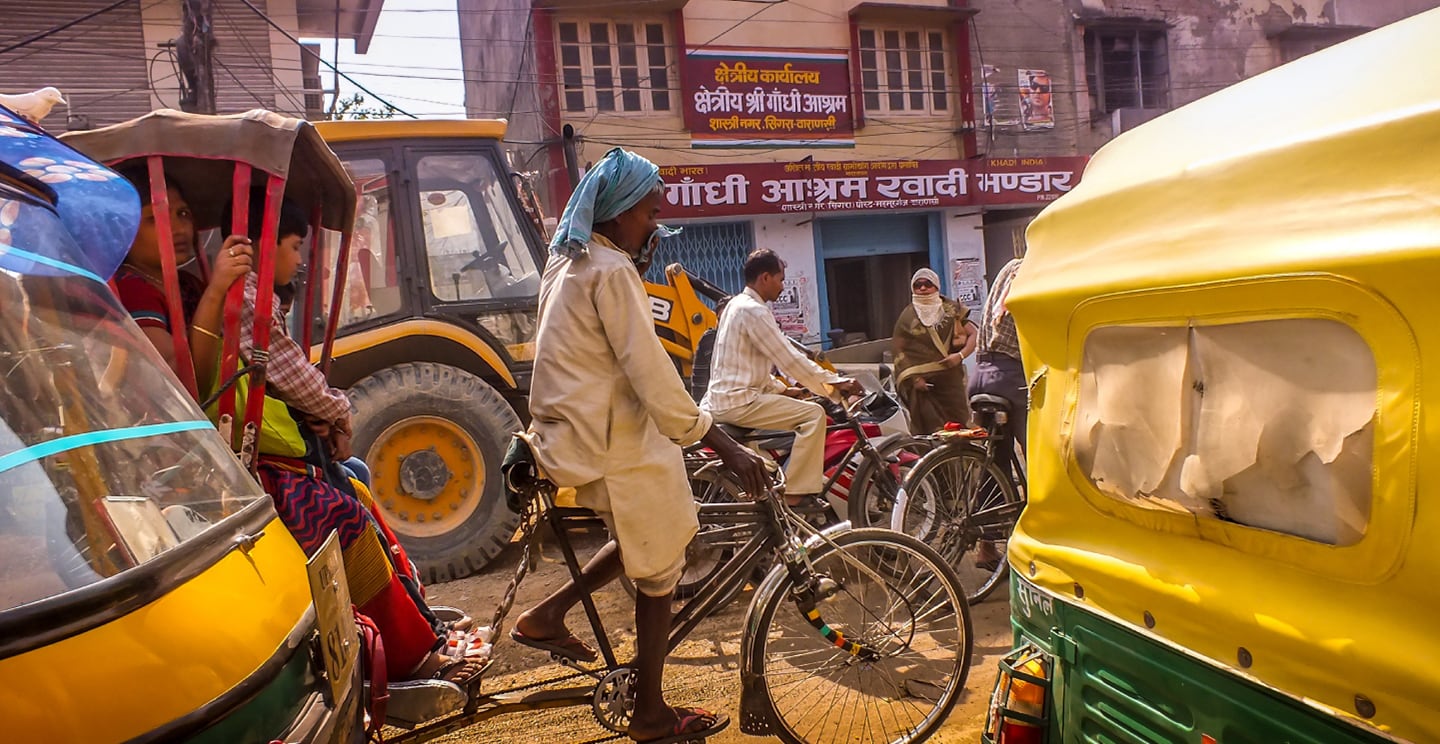As the government aims to eliminate the disease by 2025, Dr KS Sachdeva, the Regional Director at The UNION South East Asia, takes a closer look at the policy interventions that raise standards of care for Tuberculosis patients.

The days 50-year-old Dulari Devi coughs up blood, her family try to feed her a portion of dal or lentil curry with some rice. It’s the only protein-rich food they can afford, but Devi refuses to eat. “My weight has dropped but I have no appetite. I feel so weak,” she says, clasping her pale, scrawny hands.
A classic case of misdiagnosis and incorrect treatment, eight months ago, when her fever and chills worsened, she went to many doctors, each of whom treated her for seasonal cough and chest infection. “I saw no improvement so my daughter insisted we visit a private hospital. That’s when I found out I had TB.”
India is the TB capital of the world. According to the World Health Organization (WHO), the country records 2.5 million new TB cases annually.1 Accounting for nearly one fourth of all incidence globally, TB is the country’s most fatal infectious disease, killing an estimated 504,000 Indians every year.2 That’s one person, every minute.
As TB is airborne, many Indians are easily exposed to it. Like Devi, they live in small quarters with large families, where the houses lack ventilation and are a hotbed for transmission. “No one knows about this disease. We are a family of 12 confined to two rooms so it spreads quickly. Outside, there is open sewage and the water is unfiltered.” Poor living conditions, malnutrition, overcrowding and air pollution are some factors that increase the risk of TB in the country.
Having said that, to reduce its burden, India has set an ambitious target to eliminate the bacterial infection by 2025, five years ahead of the global Sustainable Development Goal target of 2030. To achieve it, the government is looking at several strategies, including early diagnosis and detection of latent TB, analysing whether vaccination can prevent the spread of the disease, shorter courses of treatment, and community involvement to help spread awareness.
The fight against TB
Although India is ramping up its efforts, it still faces some major challenges. Lack of disease awareness coupled with incorrect or delayed diagnosis, suboptimal quality of care, and the absence of patient support systems deter Indians from seeking treatment. Dr KS Sachdeva, the Regional Director at The UNION South East Asia (a global organisation supported by USAID) believes India must formulate a TB Bill at a national level to navigate its fragmented healthcare system.
“In the last five years, the Ministry of Health and Family Welfare (MoHFW) and National TB Elimination program (NTEP) have taken bold steps to increase awareness, improve healthcare-seeking behaviour and reduce stigma. The current challenge is to consolidate these initiatives and strengthen healthcare systems,” says Dr Sachdeva.
In 2020, India launched a “Jan Andolan” or people’s movement against TB. This initiative aims to further build awareness about TB, address the deep-seated stigma around the disease in the community, raise awareness about the available TB services and generate demand for TB services in the community. Efforts are put together to involve people from all walks of life including elected representatives and state government leaderships to create a mass movement and drive community ownership of the government’s efforts. It’s also providing state-of-the-art diagnostics and treatment services for all. However, Dr Sachdeva emphasises that the policies need to be “more effective on ground” in order to reach every TB patient.

“An early and accurate diagnosis during the course of the disease is the best tool to treat it rationally and prevent emergence of drug resistance due to wrong or delayed diagnosis. By enabling care at an early stage, we can improve therapy outcomes. Current molecular diagnostics are not only highly sensitive and specific, they also have the capability to diagnose the disease very early on when the bacterial counts are low,” adds Dr Sachdeva.
Patient-centric stakeholder mobilisation to tackle TB
Recognising that 70% of out-patient care is serviced by private providers, the government has engaged the private sector and initiated a number of measures to improve the quality of care.3 Apart from legislative policies like mandatory TB notification and Schedule H1 surveillance that prevent over-the-counter sale of anti-TB drugs without prescription, Dr Sachdeva says the government is also providing “financial incentives for notification and declaration of treatment outcomes and state-of-the-art diagnostic and treatment facilities.” Nikshay, a homegrown and government-enabled platform is one such example. Holding health records of over 15 million people, it was developed to capture TB data from both the public and private sectors.4 By functioning as a comprehensive, integrated system to digitise TB treatment workflows in real-time, health providers can reach out to patients through various virtual care mechanisms, and discuss treatment outcomes. According to Dr Sachdeva, such aggregated reports and dashboards inform policymakers where action or intervention is needed and is critical in the fight against TB.
“Disease eradication requires continuous and sustained surveillance. Anytime the intensity of such programmes are not optimal, the disease has a potential to resurface. Sustained funding and keeping elimination on the radar at all times while ensuring the delivery of services to match the demand needs unwavering focus.” Dr Sachdeva says an 80% reduction in TB incidence by 2025 is ambitious but says “a bold target is needed to push the nation into putting all possible efforts.”
Part of that endeavour is to tackle social stigma in the country. Beyond the physical suffering, TB has enormous mental and social consequences that remain ignored. Often, the isolation and feelings of guilt and shame lead to depression and anxiety in TB affected persons. While Devi was open to talking about her experience with TB, she was uncomfortable sharing photos of herself, fearing the consequences should people recognise who she is.
“I stay within these four walls, keeping away from family and covering my face all the time. It’s a very lonely journey,” says Dulari Devi. While Devi’s children are empathetic to their mother’s battle, many women live with fear and discrimination when infected with TB. A study that examined TB-related stigma in India found that 40% of women were uncertain if their spouses would support them after a positive tuberculosis diagnosis.5
Where stigma persists, TB thrives. Policy observers believe that if India plans to accelerate progress toward TB elimination, it needs to put patients at the centre of its healthcare delivery model. “The general and educated Indian population has to take ownership of government healthcare policies. Often they are on the fringes of policy making and do not take an active role in holding the government accountable to the policy decisions taken,” says Dr Sachdeva.
Public health programmes and policies worldwide have taught us an important lesson – that meeting targets, reducing health inequalities and disease prevalence remain an unattainable goal if communities are left out of the response mechanism. India is vigorously adopting novel strategies and steadily taking steps to end TB. However, its policies must go beyond medical interventions by addressing the social determinants and minimising barriers to diagnosis and treatment.
References:
- World Health Organization. 2020. “TB Profile.” Worldhealthorg.shinyapps.io. World Health Organization. 2020. Retrieved from https://worldhealthorg.shinyapps.io/tb_profiles/?_inputs_&lan=%22EN%22.
- World Health Organization. 2021. “Global Tuberculosis Report 2021.” Www.who.int. October 14, 2021. Retrieved from https://www.who.int/teams/global-tuberculosis-programme/tb-reports/global-tuberculosis-report-2021.
- Kumar Anurag, and Sarwal Rakesh. 2021. “Health Insurance for India’s Missing Middle”. Retrieved from https://www.niti.gov.in/sites/default/files/2021-12/Health%20Insurance%20for%20India%E2%80%99s%20Missing%20Middle_08-12-2021.pdf
- Patricia Moscibrodzki, Steven Parkinson, Raphael Ferry, Nnamdi Nwaneri, and William Thies. Mapping the Technology Landscape of National TB Programs. The Global Fund to Fight AIDS, Tuberculosis and Malaria. Geneva, Switzerland; 2021. Retrieved from https://www.theglobalfund.org/media/11422/publication_tb-ict-technology_report_en.pdf
- Atre, S., et al (2009). Global Public Health. Gender and community views of stigma and tuberculosis in rural Maharashtra, India. Retrieved from https://www.tandfonline.com/doi/abs/10.1080/17441690903334240?casa_token=GpLOn7bnKtoAAAAA%3AZQpr9hv14rke5Zz8a9PPerRzgzUXqVke47Ryauvx3HVkRgXBLOa6-pbGU2s00HPk_2kiQdxbmHzv&journalCode=rgph20














